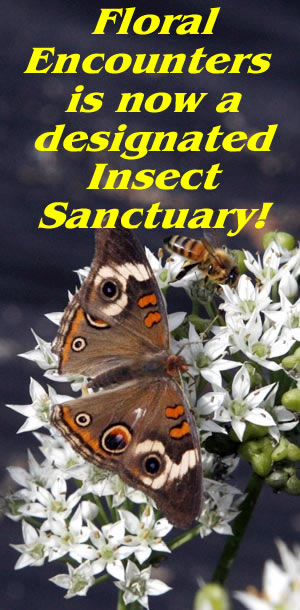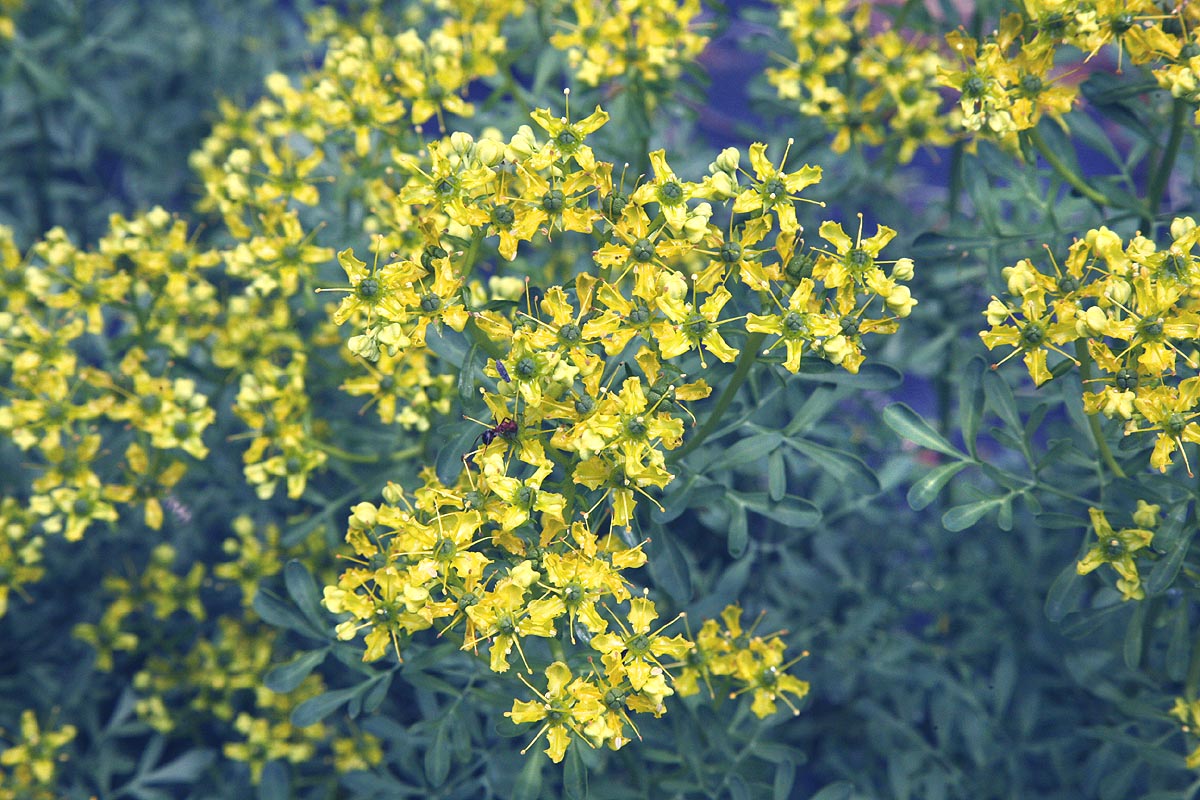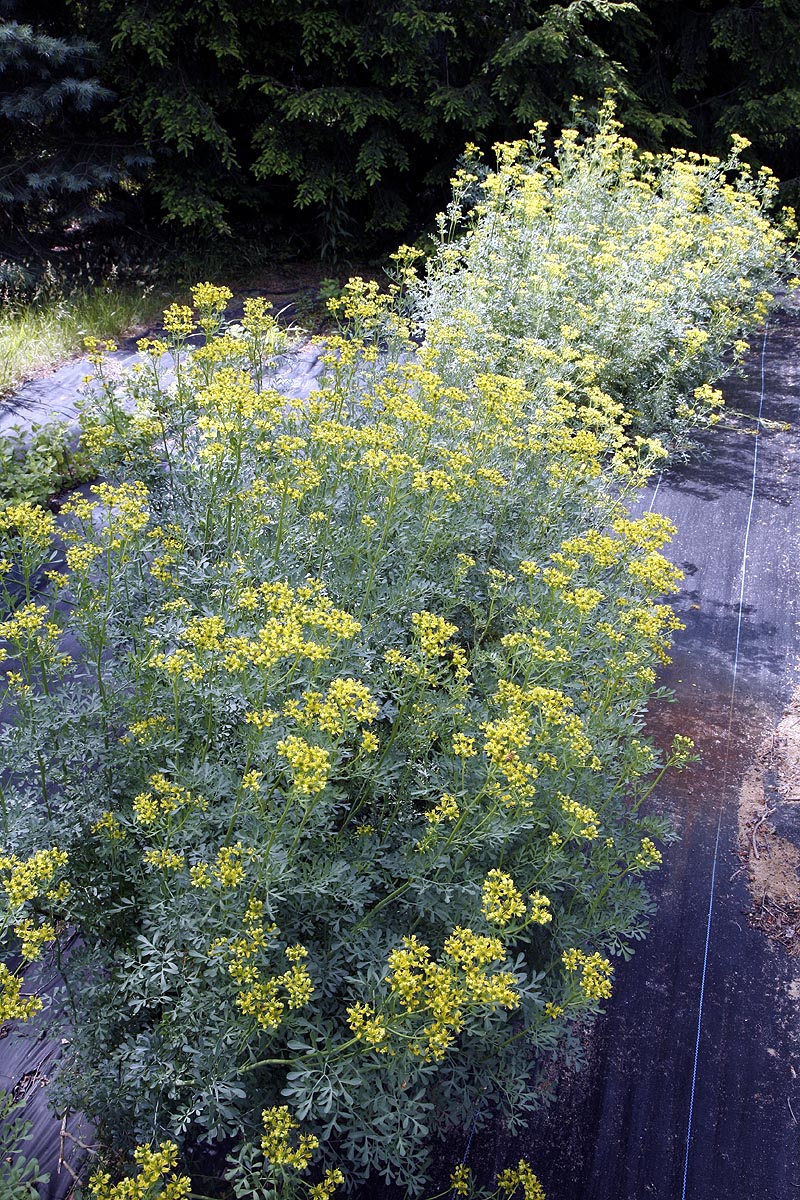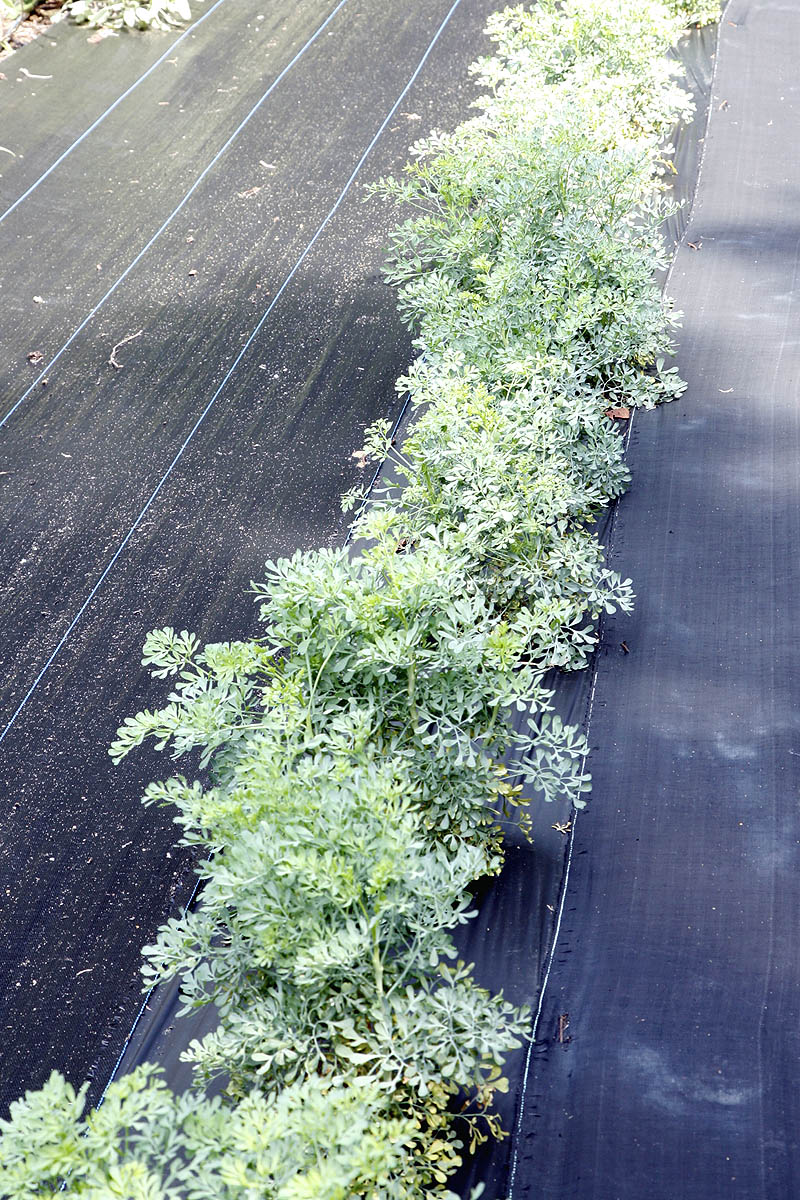A rather attractive short evergreen lived perennial with a shrub like growth. The foliage is a lovely blue green color with small compound leaves giving it a very airy spacey look. Its has a characteristic smell when brushed up against is produces a orange like aroma. When crushed it emits a powerful musk odor that is repellent to many insects including fleas and ticks. It will also repel rodents so is often planted around gardens as a hedge to help protect plants and ward off insect pests. The large number of small yellow, more chanteuse colored flowers that often cover the tops of the stems in early summer are a magnate for pollinators and its also the host plant of several species of swallowtail butterfly making it a must have plant for butterfly gardens. Easy to grow from seed Rue needs full sun and well draining soil. Does best on poor soils with very little water. Will even grow on sand and gravel. Very drought tolerant once established.
Rue produces substances known as furanocoumarins that can sensitize the skin to light and cause blistering or unpleasant and often severe skin rashes in many people. Always wear gloves and long sleeves when handling or working with rue. Do not ingest rue without consulting a licensed herbalist as it can be toxic in large doses. Dose amounts will vary depending on your size, weight and height do not assume that a dose that is fine for one person will be fine for others.
Seeds need light to germinate so do not cover.
Sowing indoors. We recommend this method because rue can be a bit erratic in germination taking anywhere from a week to 2 months to germinate. Sow in individual cell trays or in flats at least 2 inches (5 cm) apart. This way seedlings can be transplanted without disturbing still slumbering neighbours. Use a fine sterile seeding mix and moisten well. surface sow seeds the spray using a plastic spray bottle of water to ensure that the seeds have good contact with the soil. Place in warm well lit area and keep moist, not wet, until seedlings develop. Transplant when they have grown their second set of true leaves. If using flats take care not to disturb ungerminated seeds. For more details on starting seeds inside see our General Growing Instructions.
Direct sowing. Seeds can be direct sown when all danger of frost is past and ground temperatures reach 65 F (C). Prepare bed and rake soil to a fine consistency, surface sow seeds at least 8 inches apart. Then water using the mist option on your hose. Keep seeds moist. When seedlings grow thin out the weaker seedlings leave strong ones at least 24 inches (61cm) apart 30 inches (76cm) is better if you have the space.
Transplanting. space seedlings 24-30 inches (61-76cm) apart with row separation of at least four feet (1.2m). Keep watered well until plants are established.
Light. Rue needs full sun especially at the cooler end of its range. Zones 4-6b needs full sun all day long. Zones 7a-8a can tolerate a little shade at some point in the day but needs full sun for most of it. Zone 9 can tolerate a little more especially from the noon sun but not deep shade. In zones 7a and warmer ensure it is planted where it can receive breezes to keep it cooler and that the plants are open to the breeze and not planted too close together or surrounded by other plants.
Soil. It actually likes poor soil best. It needs well draining soils and prefers ones with sand, gravel or even rocks. Its excellent in areas where many other plants will not grow such as rocky slopes, sand, pea gravel. It will grow on gravel 'mulch' intended to keep weeds down. Does not like heavy clay soils, anything that wont drain well and fairly fast. If you have this kind of soil you will need to amend it around the plants with gravel and sand. Many recommend perlite and vermiculite they can be used but gravel and sand are often less expensive options and can be purchased in bulk. If you cannot amend the soil grow plants in pots or raised beds containing large amounts of sand and/or gravel.
Water. Once established it really does not need any unless there is a very severe drought. Can survive on very little water. If you location gets a lot of rainfall it will be essential to grow it on sand, gravel or a combination of these. Does not do well in even permanently damp soils.
Temperature. While Rue is hardy to zone 4 it thrives on dryer heat. Native to the Mediterranean it is used to high temperatures but with low humidity. So it will do well in desert like climates but not in humid areas like southern United States.
Fertilizer. None needed. Prefers poor soils and too much added fertilizer will impede plant growth.
Pruning. Rue takes well to clipping and pruning which is why it is often used as a hedge. This was common practice in Europe in the last century and was often grown around vegetable beds to help keep wildlife off the growing produce and help to deter insect pests. It takes well to low hedging and can become a thick and lush low growing hedge reaching about 40 inches (101cm) in height.
While Rue does not need pruning it will, if left alone become more open and straggly. This can be beneficial in hot more humid climates as it increases air flow, but is not as desirable to look at. Cutting stems back to encourage a more compact bushy structure is suggested. However it will depend on your requirements. Heavy pruning will reduce flowering and increase leaf production. If flowers are the desired outcome then less pruning should be done.
Wear gloves when pruning as leaves can produce a nasty rash in many people.
Avoid Planting Rue near tomatoes, basil, cabbage, cucumbers, or sage. When planted near these, the herbaceous perennial can inhibit growth and alter the flavor of some fruits, vegetables, and herbs.
However it is also a repellent to other insects and can be used in some fruit gardens to help control pests. It is especially good with raspberries, figs and some strawberries. It has a bitter taste so wildlife dont eat it.
If leaf is required harvest before the plants bloom. Removing flower heads will encourage more bushy plants and increase leaf production.
It is advisable not to harvest the plant much or at all in the first year of cultivation so that it has a chance to get well established. From second year onwards harvest in late spring / early summer when new growth is settling and the leaf color goes from bright green to blue green.
Always wear gloves and long sleeves when harvesting or working with rue to prevent any skin issues.
Rue has many properties one of which is its ability to reduce capillary fragility reducing bruising and especially for its strengthening action on the eyes. It also has strong its antibacterial and antifungal properties and has been used to treat nervous conditions especially headaches, giddiness, sleep disorders, arthritis, joint pain, varicose veins, palpitations, coughs, flatulence and other digestive issues. It is also reported to reduce inflammation and alleviating pain. Should not be used by pregnant women as higher doses can cause miscarriages. More recently research as show that it can potently inhibit cancer cell proliferation.
2. Also repellent for rats and many insect pests. For this reason it was often used as a strewing herb (spread on the ground or floor of a home) to help repel these insect pests, rats and mice.
3 Will repel many insects including fleas, ticks, ants and possibly cockroaches. Often made into small bags or sachets and tucked into areas where the pests are seen. Or place in linen cupboards to repel moths.
4. As a companion plant to help repel other insect pests and rodents from garden areas. Can confuse rodents that eat vegetation and keep them away. Most useful grown near roses, raspberries and other berry fruit. Strawberries may change flavor if near rue so keep those in a different area.
5. It produces a fine red dye.
6. Sometimes used in perfumes.
7. It is a flavoring ingredient in the liqueur known as grappa.
8. In folklore, rue is associated with protection and purification. It is often used in rituals and ceremonies to ward off negative energy.









